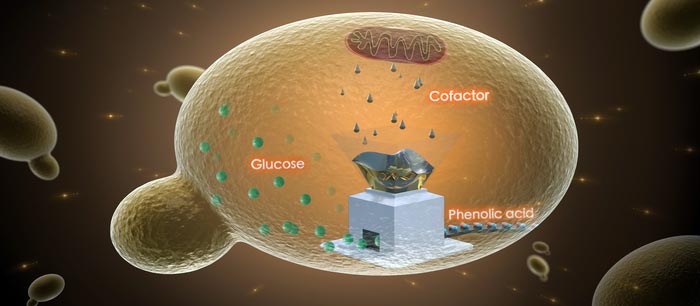Cofactor engineering drives natural product synthesis

Cofactor engineering drives natural product synthesis
Credit: DICP
In the past decade, advances in synthetic biology paved the way toward the sustainable synthesis of complex natural products.
The baking yeast Saccharomyces cerevisiae has been widely used in food industry and has become one of the main platforms for building cell factories due to its robustness, convenient cellular engineering, and reliable safety.
Recently, a research group led by Prof. ZHOU Yongjin from the Dalian Institute of Chemical Physics (DICP) of the Chinese Academy of Sciences (CAS), in collaboration with Prof. ZHANG Lei from Naval Medical University, has developed efficient cofactor engineering strategies to derive phenolic acid biosynthesis in yeast.
This study was published in Nature Chemical Biology on April 28.
The cofactor metabolism is tightly regulated and complicatedly distributed in sub-organelles in eukaryotic cell such as yeast. Thus, it requires novel and feasible engineering strategies to cope with the complex cofactor regulation.
The researchers developed tailored engineering strategies to enhance the supply, re-localization, and recycling of cofactors NADPH, FAD(H2), and SAM, which enabled high-level production of caffeic acid (5.5 g/L) and ferulic acid (3.8 g/L).
“This work reveals the regulation of different cofactors in yeast, especially the distribution of cofactors between different organelles in cells, and provides theoretical guidance for cofactor engineering,” said Prof. ZHOU. “It also provides sufficient precursors for the efficient synthesis of complex active natural products.”
The study was supported by the National Key Research and Development Program of China, the National Natural Science Foundation of China, the Liaoning Revitalization Talents Program, and the Innovation Grant from DICP.
Journal: Nature Chemical Biology
DOI: 10.1038/s41589-022-01014-6
Method of Research: Commentary/editorial
Subject of Research: Not applicable
Article Title: Engineering cofactor supply and recycling to drive phenolic acid biosynthesis in yeast
Media Contact
Jean Wang
Dalian Institute of Chemical Physics, Chinese Academy Sciences
wangyj@dicp.ac.cn
Office: 41182464221
All latest news from the category: Life Sciences and Chemistry
Articles and reports from the Life Sciences and chemistry area deal with applied and basic research into modern biology, chemistry and human medicine.
Valuable information can be found on a range of life sciences fields including bacteriology, biochemistry, bionics, bioinformatics, biophysics, biotechnology, genetics, geobotany, human biology, marine biology, microbiology, molecular biology, cellular biology, zoology, bioinorganic chemistry, microchemistry and environmental chemistry.
Newest articles

A universal framework for spatial biology
SpatialData is a freely accessible tool to unify and integrate data from different omics technologies accounting for spatial information, which can provide holistic insights into health and disease. Biological processes…

How complex biological processes arise
A $20 million grant from the U.S. National Science Foundation (NSF) will support the establishment and operation of the National Synthesis Center for Emergence in the Molecular and Cellular Sciences (NCEMS) at…

Airborne single-photon lidar system achieves high-resolution 3D imaging
Compact, low-power system opens doors for photon-efficient drone and satellite-based environmental monitoring and mapping. Researchers have developed a compact and lightweight single-photon airborne lidar system that can acquire high-resolution 3D…





















